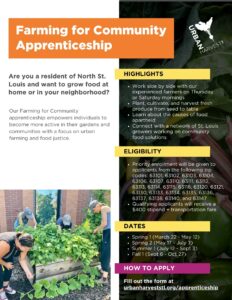Final report for FNC23-1377
Project Information
Urban Harvest STL(UHSTL) operates 5 farms in the heart of St. Louis and donates 5,000 pounds of fresh produce annually. UHSTL has been in operation since 2011 and has recently begun to offer on-farm education opportunities. In 2021, we piloted our apprenticeship program with 6 women. In 2022, we educated 20 apprentices out of 72 applicants. Upon closing the form at 72 applicants, we realized that there was a much greater demand for learning urban agriculture skills than we anticipated. In response to the success, we will continue expanding this program. Each of our 5 farms is managed by a unique farmer with a unique style and our educators help support them in conveying that style to our apprentices as outlined below.
Dameian Duwe: Oversees and helps maintain all 5 Urban Harvest STL (UHSTL) farms. Dameian’s role in the project is to assist with administrative tasks, such as determining the farm budgets and acquiring the necessary materials along with managing any on-farm equipment/maintenance/construction tasks.
Ro Kicker: Manages the Rung for Women farm, UHSTL’s largest farm at just under an acre. Rung for Women features 4 plots of 6 farm rows, 14 raised beds, and a food forest. Rung for Women, like all of our farms, uses organic growing methods that protect the local ecosystem such as integrated pest management and sheet mulching. Ro will help Arielle lead the apprentices in hands-on learning at the Rung farm by providing tasks and showcasing their unique growing methods.
Farmer/Educator-Apprenticeship: manages UHSTL’s 20 beds in the Fresh Starts Community Garden in addition to Sally’s Rooftop Garden and Terrace. The Fresh Starts Community Garden showcases growing in a shared space using organic growing methods and the Sally's farm showcases container growing in 1400 milk crates. The Farmer/Educator will lead the apprentices in hands-on learning by providing tasks and touching on the unique problems and solutions for community growers. This position is currently vacant and will be hired by February 2023.
Arielle Wright: Oversees the administrative and hands-on tasks for the education and engagement portion of the program. Arielle is responsible for the recruitment of participants, the creation of the educational curriculum and budget, and the facilitation of seminars.
Lindsay Serrano: Education and Community Engagement VISTA at Rung. She will be planning workshops, engaging the Apprentices when they are at Rung, and helping to evaluate the efficacy of the programming.
Food inequity impacts 15.8% of St. Louisans according to Feeding America. Food Apartheid in St. Louis is a lingering effect of extreme redlining and a long history rooted in systemic racism. Ninety percent of residents in the Low-Income Low-Access (LILA) census tracts we target are BIPOC families, with black families in St. Louis being 6x more likely to receive food stamps than white families. Many do not have a car. If families are able to get to a grocery store, food retailers in the historically redlined area of St. Louis tend to stock low-quality produce in low quantities that are often covered in harmful herbicides and pesticides.
Additionally, these census tracts experience the greatest consequences of environmental racism. There are fewer green spaces, fewer trees, and more paved areas north of the Delmar Divide than anywhere else in the city. These communities suffer from the urban heat island effect, flash flooding, biodiversity loss, and poor air quality.
Historically, educational opportunities on urban farms have been unpaid and inaccessible to those who cannot donate their time. To address food inequity and create food sovereignty in St. Louis, all stakeholders must be able to participate in the food system, particularly those in LILA areas.
Urban Harvest STL (UHSTL) educates people of all backgrounds on urban agriculture, sustainable and inclusive food systems, and the relationship between wellness and food through our Farming for Community Apprenticeship Program.
Our target demographic is individuals over the age of 18 that live in Low-Income Low-Access (LILA) census tracts. In order to recruit participants, UHSTL relies on our community partners, asking them to share our opportunities with their own program participants. After recognizing that unpaid hands-on educational opportunities are not accessible to much of our target population, we offered a stipend and transportation assistance to all program participants. In 2022, we saw such an increase in interest in our program that in subsequent years we will allow applicants to waive the stipend in order to make spots available to those who need it, increasing our engagement within a broader community.
In 2022, we educated 20 apprentices out of 72 total applicants. Due to the community's interest in the program and their local food system, we are expanding our program to include 24 paid apprentices and additional engagement and educational opportunities for 25 program alums.
Our apprentices take part in an 8-week, hands-on, paid education program. Weekly, apprentices work a farm shift at one of our 5 farm sites and participate in a virtual seminar that reinforces the topics they learn on the farm and introduces environmental and food justice concepts. They are also introduced to other urban growers through field trips at equity-minded community farms and gardens to help expand their community of practice. Our alumni engagement program will involve a series of workshops hosted by UHSTL and other key stakeholders that cover different urban growing topics, such as planting strawberries or container gardening.
Each of our 5 farm sites showcase a unique method of growing organically and sustainably in an urban space. Our apprentices visit each space in order to learn which method suits their circumstances the best. The Rung for Women farm is our largest farm at just under an acre, showcasing bio-intensive planting and soil regeneration in traditional farm rows, surrounded by native plants, pollinators-friendly plants, and a large food forest. The Fresh Starts Community Garden showcases growing in a traditional community garden with raised beds and allows each apprentice to learn the benefits and drawbacks of growing organically in a shared space. The Sally’s Rooftop Garden showcases container gardening using 1,400 milk crates, a gardening style accessible to those in urban areas with limited land space. Finally, the Flance and Guardian Angel Schoolyard Gardens showcase small-space organic growing for the purpose of education and consumption.
In each lesson, during each farm shift, and at each workshop, the importance of sustainability as it relates to environmental justice is stressed. Our farming methods are mindful of each ecological stressor that urban environments are plagued by, such as biodiversity loss, lack of green spaces, and the urban heat island effect. Our apprentices expand our mitigation efforts by utilizing our growing methods in low-food access neighborhoods across the city.
Objectives:
- Increase 24 apprentices’ understanding of urban agriculture and food justice through participation in farming activities and classroom lessons;
- Connect apprentices to 4 community gardeners of color and at least 2 other community leaders as an avenue of mentorship ;
- Develop Urban Growers Education and Training program to provide continued support and education opportunities, with a reported 85% satisfaction rate, 65% rate of increased knowledge of growing techniques or engagement strategies, and 40% continued engagement with community leaders or projects; and
- Increase food security for St. Louis residents through the production and distribution of 3,000 pounds of food with the support of apprentices.
Cooperators
- (Educator)
- (Educator)
- (Educator)
- (Educator)
- (Educator)
- (Educator)
Research
Urban Harvest STL (UHSTL)’s Apprenticeship began with recruitment in February with help from partners serving the target LILA demographics. The application is in the form of a google survey and includes questions like “what is your prior relevant experience” and “what do you hope to get from this program” along with demographic information. During the selection process UHSTL ensured 60% or more of selected applicants came from specifically targeted LILA zip codes. Applicants chose either the spring or summer 8-week session (May-July and July-October) and chose either a weekday or weekend group to make it the most accessible to as many schedules as possible.
Over the 8 weeks, Apprentices visited 3 of UHSTL’s 5 farms, excluding the two school gardens as maintenance cannot occur when children are using the outdoor space. Each farm shift was 4 hours long and covered topics ranging from sheet mulching to broad forking to planting to weeding and more. The weekly educational seminars occurred virtually but will be in person before the farm shift next season to increase engagement and community building and to reinforce the topic with hands-on practice. Weekly seminars covered environmental and food justice topics, connecting the physical labor to the social benefit. UHSTL facilitated on-going “harvest day” shifts so Apprentices could take home food for themselves weekly during and after their time in the program.
Each session (spring and summer) had 2 field trip opportunities to local BIPOC farms to encourage community building. Each host farm received an honorarium of $200. As a white-led organization, UHSTL understands it is important to uplift BIPOC voices in the urban agricultural space and compensate them for their work. It is also important for new growers to learn from practicing farmers that understand the world of urban agriculture through a BIPOC lens. This same logic is applied to the workshop series, where local BIPOC growers are featured as guest speakers.
UHSTL’s workshop series covered a range of topics and 5/7 workshops were presented by a BIPOC guest speaker. Guest speakers received $100 for supplies and $200 for presenting. UHSTL surveyed participants for satisfaction and increased knowledge at the end of each workshop. They surveys are in the form of google surveys and include Strongly Agree-Strongly Disagree scales for questions such as “I learned something useful today” and Satisfied-Dissatisfied scales. Not every participant took part in the survey due to the capacity of the organization to collect surveys while facilitating, ideally every participant would respond. Many Apprentices participated in workshops, creating further community building opportunities.
At the end of each Apprentice session, Apprentices were assessed at a final celebration and received their $400 stipend. Having a social gathering as incentive encourages attendance and organic feedback. UHSTL used pre- and post- surveys to assess the Apprentices’ knowledge gained. The pre-survey included questions like “How familiar are you with ____ topic” and “Do you feel confident in ___ skill”.
UHSTL will be changing this method next season to post-experience assessment. It is difficult for Apprentices to assess their knowledge of urban farming topics before any learning experience. Many times, participating in the Apprenticeship program resulted in lower post -survey results as apprentices learned more about the topic and reassessed what they have yet to learn. These assessments will also give more guidance on the responses. Rather than giving participants a simple Likert scale, responses will include textual guidance (e.g. 1- I have no knowledge of topic, 2 - I have some knowledge of topic, 3 - I feel confident in topic, 4 - I could teach/lead other in topic).
UHSTL also surveyed Apprentices on their satisfaction with the program and interest in continued engagement at the end of the program using the Satisfied-Dissatisfied and Agree-Disagree scales along with open ended questions. Surveys are easiest to collect in person with an incentive like food. Any open-ended feedback is used to tweak the program for next season.
26 Apprentices participated in the program, an increase from 20 the year prior. The Apprentices were introduced to 7 community growers of color through field trips and workshops.
Highlights include:
- 95.8% "high satisfaction" rate from responding Apprentices who completed the program.
- In addition to the 95% satisfaction and 100% rate of increased knowledge,
- 69% of participants stated they plan to continue engagement with community host farms in 2024.
- 100% of responding participants increased their score on the knowledge assessment following participation in the program.
- 6,517 pounds of fresh produce across all 5 farms, an increase from 3,705 pounds the prior year.
UHSTL allowed Urban Growers Engagement workshop participants to participate in a survey after the workshop. Survey respondents indicated 100% satisfaction and 100% increased knowledge.
UHSTL increased local food access in St. Louis by growing 6,517 pounds of fresh produce across all 5 farms, an increase from 3,705 pounds the prior year. Produce was weighed at each harvest and tracked in a harvest log. Harvest from the Rung for Women farm was distributed to Apprentices and Rung members in a free pop up market on the Rung for Women campus that, in the height of the growing season, was distributing food for participants to take home 4 days out of the week. Any volunteers were also welcome to the harvest.
Harvest from Sally's Rooftop Garden and Terrace and Fresh Starts Community garden similarly was distributed to Apprentices and volunteers on harvest days or as needed with any excess being donated to LifeWise food pantry. Any produce not distributed to the community was used for events, like Raise the ROOF, where we shared the successes of the programs.
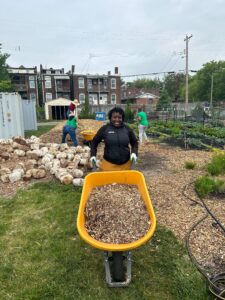
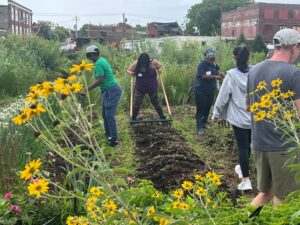
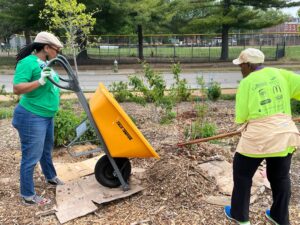
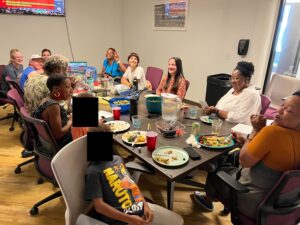
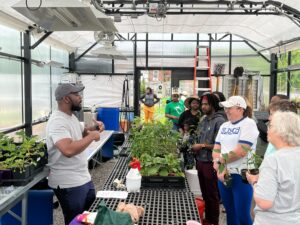
Educational & Outreach Activities
Participation Summary:
- On-farm demonstrations:
- 4 total sessions of 1 shift per week for 8 weeks = 32 hands on farm lessons
- Online trainings:
- 8 virtual lessons per cohort x 2 cohorts = 16 virtual lessons
- Webinars, talks and presentations:
- 1 Presentation on Food Justice at Missouri Botanical Garden
- Workshop / field days:
- 7 workshops
- Other Educational Activities:
- 4 field trips to BIPOC farms
Outreach Approach:
UHSTL used their network of partner farms, the BRIC Network, and food distribution organizations supported by Operation Food Search to distribute information about the Apprenticeship program and recruit participants.
Throughout the season UHSTL shared project updates and success stories on social media. UHSTL celebrated milestones in each Apprentice cohort, including start and finish dates and field trips. Other posts included apprenticeship farm activities, produce apprentices grew in their own spaces, food prepared with the produce grown, weekly harvests, and apprentice testimonials.
UHSTL received two new grants in October 2023 from the USDA to sustain the Apprenticeship program and build upon it. They have since created a campaign surrounding the Grandel Square Center for Urban Agriculture. The campaign officially started at their Raise the ROOF end-of-year celebration, where they also shared successes from the Apprenticeship. As UHSTL is working closely with NRCS staff thanks to funding for this program, results have been and will continue to be shared with them and their networks.
UHSTL was featured in a number of news pieces that spoke briefly about their programs. UHSTL has also spoken about their Apprenticeship in the local community, such as when they presented at the Building Resilient and Inclusive Communities (BRIC) Collaborative Network gathering in November 2023.
Press:
UHSTL website collection of press
Info/Materials:
UHSTL website Apprenticeship program about page
Social Media Posts:
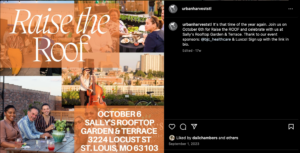
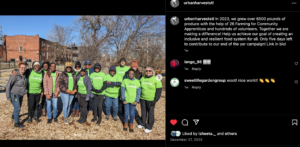

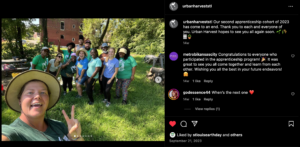
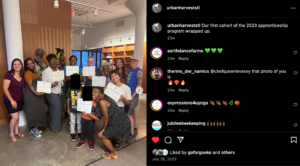
Find more posts about our programs @urbanharveststl
Learning Outcomes
Access to education, resources, and a community of practice are huge barriers for those wanting to start growing food. By providing a paid apprenticeship, those participating are being compensated for the time spent working on Urban Harvest STL’s farms while learning the basics of farming. After adding a stipend for participation, UHSTL saw an increase in participation from individuals living in Low-Income Low-Access areas. With the addition of the Apprenticeship+ program, alumni have access to additional resources and support through mutual aid and peer networking, Urban Harvest STL resources and connections, and ongoing training through the workshop series.
There continue to be challenges that UHSTL is looking for solutions. For example, The organization is not able to provide childcare for Apprenticeship participants. Likewise, some apprentices struggled to attend the online seminar on a weekly basis. Given the varying level of access to and comfort with technology, not all apprentices were able to consistently participate in the virtual lessons. In 2024, UHSTL will phase out virtual learning. Rather than require separate sessions, these lessons will be incorporated into the weekly farm shifts, to lessen demands on time and technology.
Our biggest take-away from this program is to build in opportunities for people to interact, get to know one another and learn from each other. In 2023, our apprentices were markedly more involved with the content, with each other, and with the organization as a whole. Two apprentices have since received jobs with food and environmental justice organizations, two joined the Urban Harvest STL Board of Directors, and another apprentice is expected to join the Urban Harvest STL staff in 2024. For others, the Apprenticeship +, a mutual aid support network involving current and former Apprentices, will provide a structure for program alumni to work together to support their own growing spaces. Through this program, participants will have access to resources from UHSTL such as seed starting in the greenhouse or collecting compost and leaf mulch for their own gardens. We are currently developing additional strategies to help strengthen the community of practice apprentices developed this past year.
Project Outcomes
“Getting to meet people from the community really inspired me to be a part of urban farming. I felt a sense of community and connection.”—2023 Cohort 2 Apprentice
“I got to learn more about the organizations and to meet some of the inspiring people doing the work to establish resilient food systems”—2023 Cohort 1 Apprentice
“This opportunity has grown many of us in ways you couldn't have imagined… This opportunity gave me a voice again… I haven't felt this alive and connected to something in a very long time and being in the dirt with all of our cohort was awesome and beautiful!” —2023 Cohort 1 Apprentice
In order to attract low-income and disadvantaged participants, beginning farmer training opportunities must be compensated. Addressing other barriers, like childcare and transportation, will further increase accessibility for low-income participants. Technology can be a barrier to low-income, elderly, and some disabled farmers, so utilizing low to no tech ways to interact helps with engagement and accessibility. Having flexibility in scheduling, with weekend and weekday options has also increased participation. UHSTL would recommend hosting an evening (5pm or later) session if there is capacity to do so within the organization.
